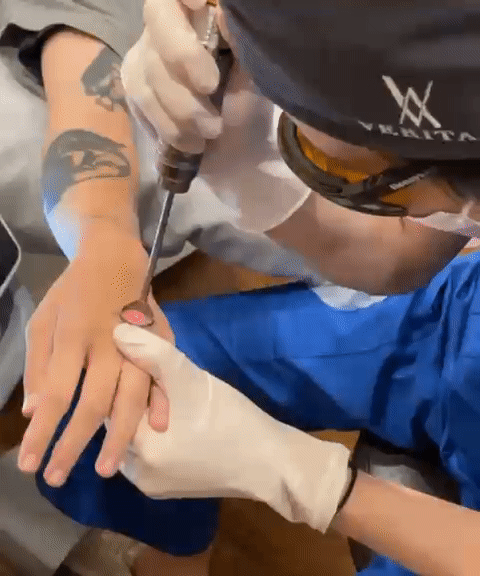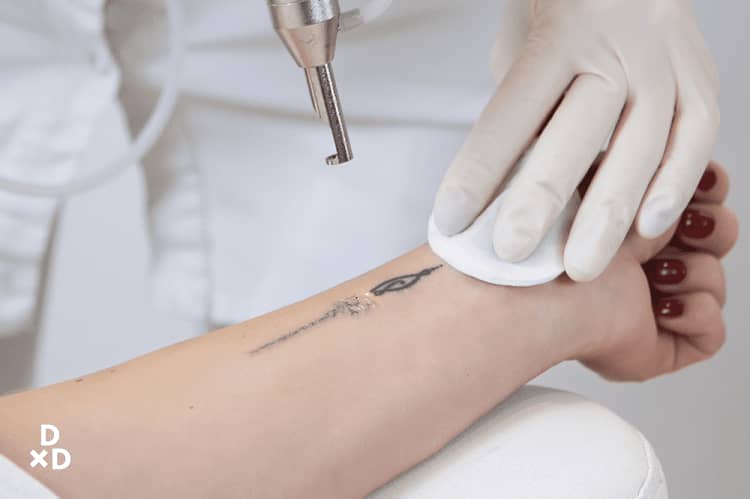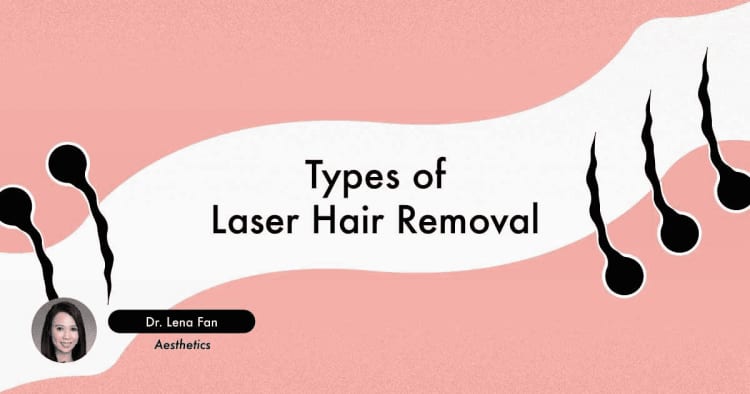Gone are the days when tattoos are permanent. A survey has shown that 75% of people regretted one or more of their tattoos – that’s 3 out of 4 people! [1]
Thankfully, the rise of tattoo removal procedures has helped with tattoo regrets. We can now erase the tattoos that we do not want with a variety of tattoo removal methods such as surgery, or lasers.
Read on to find out everything you need to know about tattoo removal.
How is tattoo removal with lasers done in Singapore?
Tattoo removal with lasers is done by hovering an applicator over the tattooed area. The lasers shoot pulses of high-intensity laser energy through the epidermis (topmost layer) of your skin and are absorbed by pigments from your tattoo [2].
The absorption of laser energy causes the tattoo pigments to shatter into smaller particles and are metabolised or excreted from your body via the lymphatic system over a couple of weeks. The tattoo will then look lighter.
In Singapore, 2 types of lasers are commonly used to help with tattoo removal – the quality-switch (QS) nanosecond laser and the QS picosecond laser.
QS nanosecond laser
The QS laser is traditionally considered the gold standard in tattoo removal due to its outstanding clinical results and safety profile [3], and consist of three types – the QS ruby laser, the QS Nd:YAG laser and the QS alexandrite laser.
The differences between these three lasers are listed in the table below [4], [5]:
Ruby laser
Nd:YAG laser
Alexandrite laser
Wavelength
694nm
1064nm and 532nm
755nm
Tattoo pigments [6]
- Black
- Blue
- Green
- Purple
1064nm:
- Black
- Blue
532nm:
Red
Orange
Black
Blue
Green
Used for
Very darkly coloured professional and amateur tattoos
Traumatic tattoos
Medical tattoos
Well suited for dark-skinned individuals
Generally results in less blistering compared to the ruby laser or alexandrite laser
Very darkly coloured professional and amateur tattoos
Traumatic tattoos
Individuals with skin types III and IV (darker white skin and light brown skin) [7]
QS Picosecond lasers
Another laser that is commonly used in Singapore for tattoo removal is the QS picosecond laser, or pico laser. The popularity of the newer pico laser stems from its improved efficacy in removing tattoos in fewer sessions as compared to the QS nanosecond laser.
Pulses of high-intensity laser energy are emitted in shorter intervals in pico lasers (picoseconds in pico lasers and nanoseconds in nanolasers). This translates to higher efficacy in removing tattoos with a lower risk of adverse side effects [8].
Studies have also shown that pico lasers are more effective in clearing multi-coloured tattoos as compared to QS nanosecond lasers, especially for dye-resistant colours like yellow, green, purple and red [9].
There are a few types of pico lasers available in the market, and their differences are listed in the table below [10]:
Ruby laser
Nd:YAG laser
Alexandrite laser
Pulse dye laser
Wavelength
694nm
1064nm and 532nm
755nm
585-595nm
Tattoo pigments [10]
- Black
- Blue
- Green
1064nm:
- Black
- Blue
- Green
532nm:
Purple
Red
Yellow
Orange
Black
Blue
Green
Red
Yellow
Orange
FracTat™ or FracPICO - Combining pico lasers with fractional laser
When tattoo pigments are fragmented into smaller pieces by laser beams, gases are produced, which shield the underlying tattoo pigments from laser beams. This results in less effective subsequent treatments with longer treatment duration, as well as a higher risk of blistering and scarring due to a buildup of trapped pressure within the skin.

Pre-treating the skin with fractional ablative laser technique, also known as FracTat, involves drilling micro-sized holes into the skin over the tattoo, which acts as pressure relief ducts through which gases can escape after each pass of the picosecond laser.
With this method, tattoo removal is safer as the chances of blistering and scarring are minimised, and the overall number of sessions needed for clearance is fewer as a larger amount of pigment particles can be broken up each time.
Lastly, due to the effects of fractional resurfacing, improvements in skin texture and existing scars can also be seen.

Is tattoo removal painful?
Tattoo removal with a laser can cause discomfort but does not cause serious pain – much like being snapped by a rubber band. Patients will have numbing cream applied prior to the tattoo removal procedure in order to minimise any discomfort that they might feel [11].
After the procedure, it is normal to feel some soreness from the swelling that occurs from the tattoo removal process [12]. Should the patient opt for another method other than FracTat, blistering may also occur that cause more significant pain and downtime.
Also read: How painful is laser tattoo removal?
Will tattoo removal leave a scar?
With scientific advances, tattoo removal with lasers today generally does not leave a scar if done properly by a professional. Scarrings that patients may observe after a tattoo removal are usually the result of the tattooing process, not the tattoo removal [13].
This is especially common in individuals who have a history of keloids (overgrowth of scar tissue) or are predisposed to scarring.
However, scarring can sometimes occur when tattoo by-products are trapped or lodged under the skin due to incomplete removal, or when gas expansion occurs as a result of the laser energy reacting with the tattoo pigments [14]. Opting for the FracTat method will prevent these occurrences due to the drilling of microholes that function as pressure relief ducts.
Doctors’ inexperience in handling the equipment or improper aftercare techniques can also lead to scarring [15]. As such, it is very important to choose an experienced professional for your tattoo removal procedure and follow the aftercare procedure carefully.
For surgical tattoo removals, the tattooed area is cut out and the skin around the tattoo is stitched back together [16]. This method usually leaves a scar, which will take several months to fade.
Is tattoo removal dangerous?
While tattoo removal is considered safe, there are also accompanying risks and complications. Studies have shown that there is a 5% incidence rate of complications occurring following a laser tattoo removal [17].
Some risks and complications that occur as a result of tattoo removal include [18]:
- Infection
- Poor wound healing
- Possible need for further surgery
- Permanent skin discolouration
- Scarring
What to expect during a tattoo removal session in Singapore?
Tattoo removal sessions are simple and fast, with minimal downtime.
There will usually be a consultation before the first tattoo removal session for the aesthetician to take a closer look at your tattoo. The aesthetician will typically use the Kirby-Desai Scale to estimate the number of treatment sessions required and how long each session will take [19].
Factors that will affect the rate of tattoo removal include the Fitzpatrick skin type, ink colours, tattoo layering, location of the tattoo on the body, amount of ink used in the tattoo as well as the presence of any scars [13].
Before the tattoo removal procedure begins, your skin will be cleaned and a topical anaesthetic is applied to the tattooed area to help numb it. You will also be given protective eye goggles to protect your eyes from the light emitted from the laser during the procedure.
The type of laser chosen for the tattoo removal will depend on the tattoo colour, the location of the tattoo as well as the skin type.
Also read: 7 things to prepare before your laser tattoo removal


To ensure that the correct energy and pulsation are used, I will test your skin’s response to the laser [20]. Following that, I will carry out the actual removal procedure, which can last a couple of minutes to even an hour, depending on the size of your tattoo [21].
After the tattoo removal session, cooling will immediately be applied to the tattooed area to soothe the skin. Thereafter, you are able to return to your daily activities without much fuss. You will be given information on aftercare tips to help the healing process.
How many sessions does it take for effective tattoo removal in Singapore?
Most people undergo about 5-10 sessions for their tattoo to be removed [22], while some may require more than 10 sessions for the tattoo to fully fade. This is usually determined during the consultation and dependent on many factors such as the Fitzpatrick skin type, ink colours, tattoo layering, location of the tattoo on the body, amount of ink used in the tattoo as well as the presence of any scars [13].
Each session will be spaced a minimum of 6 weeks apart [23]. This is because the tattoo pigments are broken up into smaller pigments by the laser during the tattoo removal session.
The smaller pigments are then removed by the body’s lymphatic system over a few weeks.
Spacing out the sessions can ensure that the body is able to effectively eliminate the tattoo pigments, as well as to ensure that your skin is completely healed before the next session [24].
In total, the entire duration of tattoo removals can span from a few months to a year.
Also read: How fast does one expect to see results after tattoo removal?
How effective is laser tattoo removal? Can you completely remove a tattoo?
Laser tattoo removal is considered one of the most effective and non-invasive ways to remove a tattoo. A study has shown that up to 80-90% of a tattoo can be removed in just 4-6 sessions using the FracTat method that combines QS pico laser with Fractional laser. As for the traditional QS laser treatment, more than 70% of patients achieve tattoo removal success only after 15 sessions [25].
Also read: Can tattoos be completely removed in 1 session?
It is possible for a tattoo to be completely removed. However, it still depends on several factors, such as the colour of the tattoo and the depth of colour pigments in the skin.
For example, green, blue, purple and orange dyes are resistant to laser removal [26], and may affect the effectiveness of complete tattoo removal. Black or blue coloured tattoos can be removed the easiest as they are better at absorbing light [27].
Also read: Which tattoo ink colours are the easiest to remove?
Are the results of laser tattoo removal permanent?
Yes, the results of laser tattoo removal are permanent. This is because the colour pigments of the tattoos are broken up into smaller particles, which are then metabolised by the body’s lymphatic system [28].
The colour pigments will then be excreted out of the body over time. As such, the removal of these colour pigments from the body is permanent, and will not return or become visible again.
Do tattoo removal creams really work?
There are tattoo removal creams in the market that claim to be able to remove tattoos. These creams usually contain trichloroacetic acid (TCA) which helps to remove tattoos by peeling away the epidermis (top layer of the skin) and allowing the tattoo to come off [29], [30].
However, tattoos reach the dermis (second layer of the skin), and the tattoo pigments are not absorbed by the TCA found in tattoo removal creams. The U.S. Food and Drug Administration (FDA) has also not found any clinical evidence suggesting that tattoo removal creams are effective [28], and have not approved the use of any tattoo removal creams. As such, the effectiveness of these creams is generally quite limited.
Furthermore, if used incorrectly, TCA can cause many complications such as difficulty breathing, nausea or even chemical burns [31].
Also read: How effective is tattoo removal cream?
What are the side effects of tattoo removal?
Some common side effects of tattoo removal include [17]:
- Redness
- Swelling
- Tenderness
- Blistering
- Bruising
- Scabs
- Hypopigmentation or hyperpigmentation
These side effects are normal and are expected to go away by themselves after 1 to 10 days. Depending on your skin type, it can play a part in the severity of the side effects.
However, complications such as allergic reactions can occur following a tattoo removal [32]. If you suspect a possible allergic reaction, or if the side effects are worsening, please visit your doctor immediately.
Also read: How much scarring can I expect after tattoo removal?
Does laser tattoo removal stop hair growth?
No, laser tattoo removal does not stop hair growth.
The hair follicles are found in a deeper layer of the dermis called the reticular dermis, compared to the colour pigments of tattoos. As such, during laser tattoo removal, it is highly unlikely that the lasers are able to reach the hair follicles, stopping hair growth.
This is because the wavelengths used in laser tattoo removals are specifically targeting the colour pigments from tattoos. These wavelengths are different from lasers used in hair removal. The pulse duration used in laser tattoo removals is also much shorter. Hence it is very unlikely to stunt hair growth [33].
How long do I have to wait until I can remove a tattoo?
If you feel that your tattoo did not turn out the way you expected, the earliest that you can remove a tattoo is at least 6 weeks after getting your tattoo. This is to allow your tattoo to fully heal before removing it, which will reduce the occurrence of side effects such as scarring and blistering [34].
Tattoos that are not fully healed will also take a longer time to remove [34].
What is the cost of tattoo removal procedures in Singapore? Are they Medisave claimable?
The cost of a laser tattoo removal procedure in Singapore is about $800-$1,300 per session [35]. The cost can vary depending on factors such as the size of the tattoo, colours in the tattoo, your skin type, the location of the clinic as well as the doctor’s experience.
Laser tattoo removal in Singapore can be claimable by Medisave [36]. Depending on the classification of your tattoo removal procedure and its respective table, the maximum amount claimable by Medisave also differs. [38]
Description
Table
Maximum amount claimable
Skin, tattoo (1%-2%), laser excision
2B
$750
Skin, tattoo (less than 1%), laser excision
1C
$450
Skin, tattoo (multiple/more than 2%), laser excision
3A
$1,250
Skin, tattoo, repeated laser excision
1A
$250
**
What are some aftercare tips after tattoo removal?**
It is important to care for your skin properly after getting a tattoo removal to ensure that infection or unwanted side effects do not occur.
Here are some aftercare tips to help in your recovery after a tattoo removal session [38], [39]:
- Keep the treated area clean and dry.
- Lightly clean the treated area with soap and water, patting it to dry.
- Apply antibiotic ointment on the treated area and keep the area in a bandage for the first three days after the tattoo removal procedure.
- Avoid swimming, baths, pools and hot tubs.
- Avoid picking at any scabs or blisters.
- Apply a cold compress or soothing ointment to help with itching or pain.
- Avoid taking aspirin.
- Avoid excessive sun exposure. Apply sunblock with SPF 25 or higher for at least three months after the procedure.
- Avoid vigorous exercise for 24 hours after the procedure.
- Drink more water.
Also read: How can I get the best results after tattoo removal, and what is the recovery process like?
Conclusion
Even with the availability of tattoo removal procedures, it is still important not to rush into getting a tattoo. Take your time to decide and be 100% sure that the tattoo is what you want, lest you have tattoo regrets and end up spending more money to remove it.
Do speak to your doctor if you are planning to get your tattoo removed!
You don't have to live with tattoo regrets anymore. Find a doctor whom you can trust to help in your tattoo removal journey.












